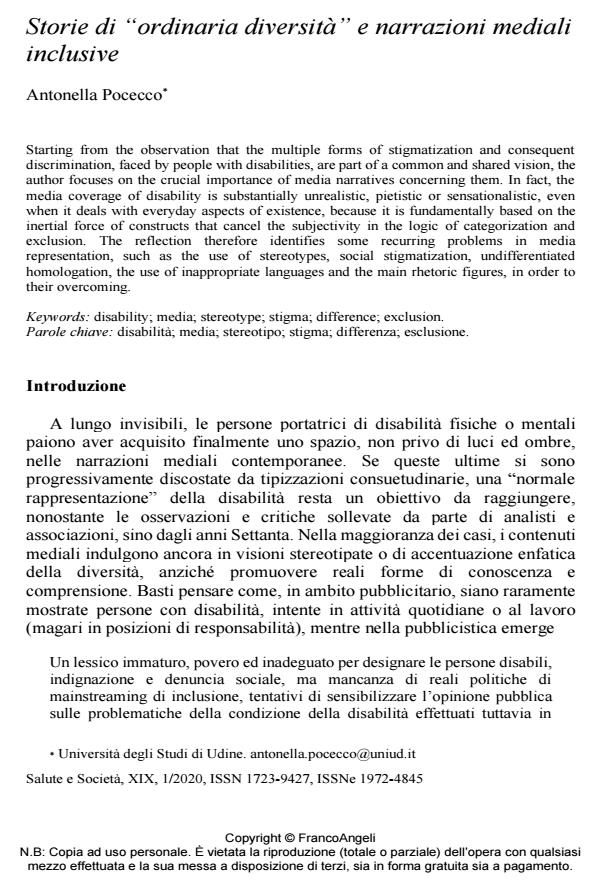Storie di "ordinaria diversità" e narrazioni mediali inclusive
Journal title SALUTE E SOCIETÀ
Author/s Antonella Pocecco
Publishing Year 2020 Issue 2020/2 Language Italian
Pages 12 P. 136-147 File size 327 KB
DOI 10.3280/SES2020-002010
DOI is like a bar code for intellectual property: to have more infomation
click here
Below, you can see the article first page
If you want to buy this article in PDF format, you can do it, following the instructions to buy download credits

FrancoAngeli is member of Publishers International Linking Association, Inc (PILA), a not-for-profit association which run the CrossRef service enabling links to and from online scholarly content.
Starting from the observation that the multiple forms of stigmatization and consequentdiscrimination, faced by people with disabilities, are part of a common and shared vision, theauthor focuses on the crucial importance of media narratives concerning them. In fact, themedia coverage of disability is substantially unrealistic, pietistic or sensationalistic, evenwhen it deals with everyday aspects of existence, because it is fundamentally based on theinertial force of constructs that cancel the subjectivity in the logic of categorization andexclusion. The reflection therefore identifies some recurring problems in mediarepresentation, such as the use of stereotypes, social stigmatization, undifferentiatedhomologation, the use of inappropriate languages and the main rhetoric figures, in order totheir overcoming.
Keywords: Disability; media; stereotype; stigma; difference; exclusion.
- Aa.Vv. (2012). Disabilità e media. La rappresentazione delle persone con disabilità nel sistema italiano dell’informazione. Roma: Fondazione Giacomo Matteotti. Baynton D. (2006). “A Silent Exile on This Earth”: The Metaphorical Construction of Deafness in the Nineteenth Century. In: Lennard J.D., a cura di, The Disability Studies Reader. New York – London: Routledge.
- Boehm G. (2009). La svolta iconica. Modernità, identità, potere. Roma: Meltemi.
- Brown R. (1995). Prejudice. Its Social Psychology. Oxford: Blackwell.
- Codeluppi V. (2007). La vetrinizzazione sociale. Il processo di spettacolarizzazione degli individui e della società. Torino: Bollati Boringhieri.
- Dahl M. (1993). The Role of the Media in Promoting Images of Disability - Disability as Metaphor: The Evil Crip. Canadian Journal of Communication, 18(1). -- Testo disponibile al sito: https://cjconline.ca/index.php/journal/article/view/718/624 (15/07/2019).
- Goffman E. (2003). Stigma. L’identità negata. Verona: Ombre Corte (ed. orig.: Stigma. Notes on the Management of Spoiled Identity. London: Penguin, 1963).
- Harnett A. (2000). Escaping the Evil Avenger and the Supercrip: Images of Disability in Popular Television. Irish Communication Review, 8(1): 21-29. DOI: 10.21427/D7271
- Hevey D. (2006). The Enfreakment of Photography. In: Lennard J.D., a cura di, The Disability Studies Reader. New York – London: Routledge.
- Hunt P., a cura di (1966). Stigma: The Experience of Disability. London: Geoffrey Chapman.
- Lennard J.D. (1995). Enforcing Normalcy. Disability, Deafness and the Body. London – New York: Verso.
- Oliver M. (2004). The Social Model in Action: If I Had a Hammer. In: Barnes C., Mercer G., a cura di, Implementing the Social Model of Disability: Theory and Research. Leeds: The Disability Press.
- Patete A. (2016). Niente stereotipi, per favore. SuperAbile Inail, 12: 8-17. -- Testo disponibile al sito: https://www.superabile.it/staticrivista/2016/12/superabile_magazine_201612.pdf (02/09/2019).
- Pirsl D., Popovska S. (2013). Media Mediated Disability: How to Avoid Stereotypes. International Journal of Scientific Engineering and Research (IJSER), 1(4): 42-25. -- Testo disponibile al sito: https://www.ijser.in/archives/v1i4/SjIwMTM2NA==.pdf (10/07/2019).
- Shakespeare T. (2006). The Social Model of Disability. In: Lennard J.D., a cura di, The Disability Studies Reader. New York – London: Routledge.
- Stiegler B. (2008). “Iconic Turn” et reflexion societale. Trivium, 1. -- Testo disponibile al sito: http://trivium.revues.org/308 (28/06/2019).
- Zappaterra T., Cugusi C. (2013). Media e disabilità nella pubblicistica contemporanea. Media Education – Studi, ricerche, buone pratiche, 4(2): 133-154. -- Testo disponibile al sito: http://riviste.erickson.it/med/wpcontent/uploads/2_Zappaterra_Cugusi_II_2013_final.pdf (29/08/2019).
Antonella Pocecco, Storie di "ordinaria diversità" e narrazioni mediali inclusive in "SALUTE E SOCIETÀ" 2/2020, pp 136-147, DOI: 10.3280/SES2020-002010